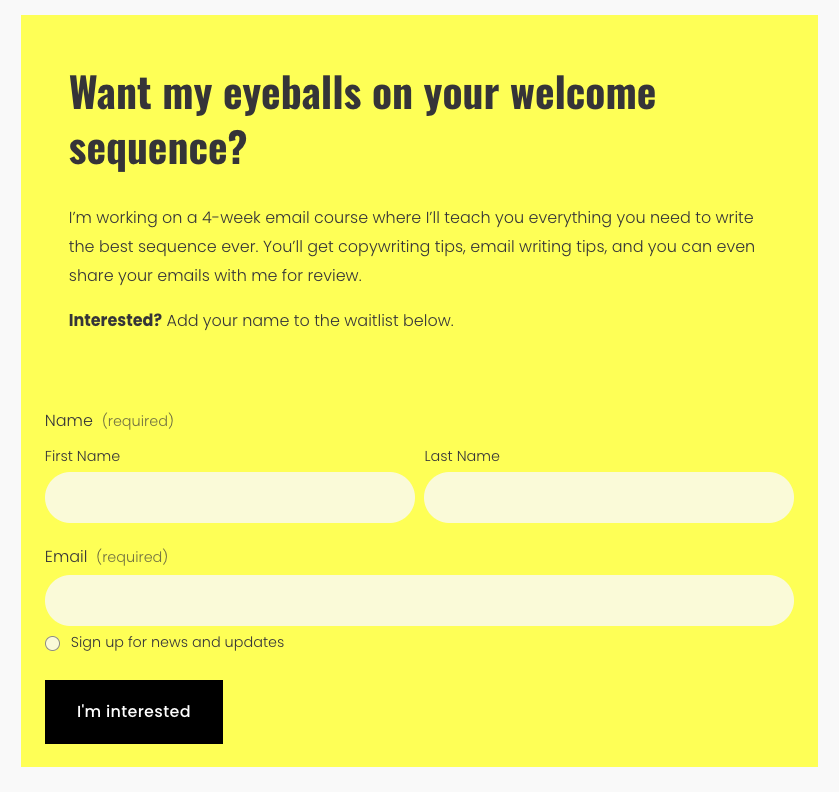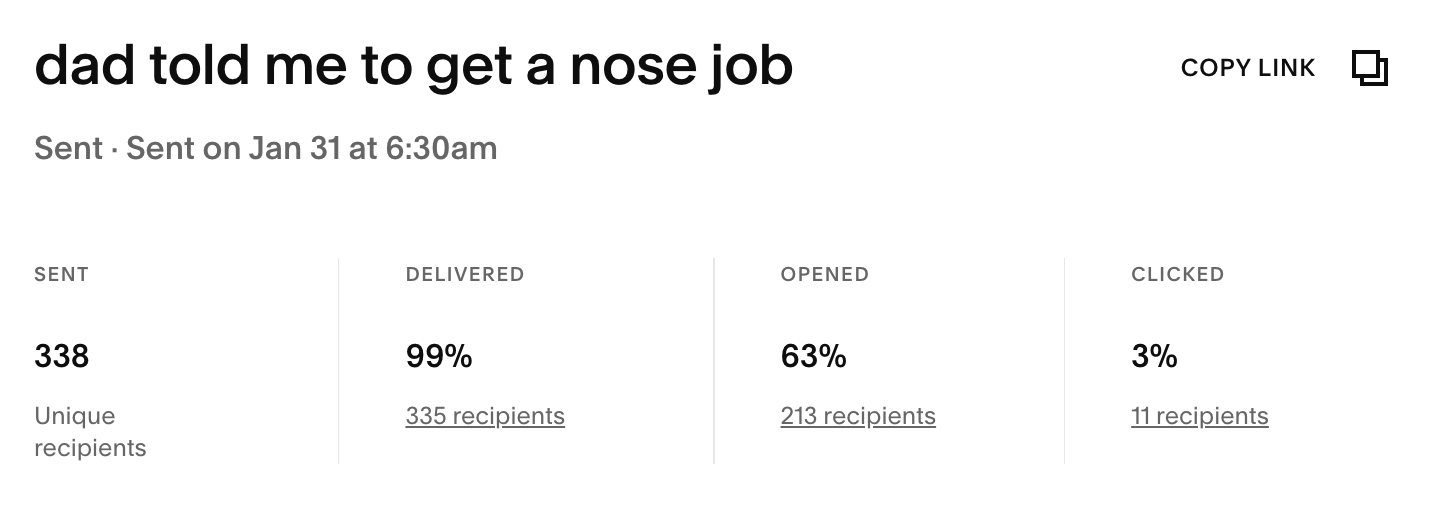It took me 748 days to launch my first 4-week group course 🐢. Let’s debrief ↓
Hi, I’m Nadia, aka Michaelangelo, and building my email marketing course, Hit Send was my Sistine Chapel.
Did I need to take almost 3 years to create a course?
Probably not.
But also, let’s normalise taking a long-ass-time to do things we’ve never done before, yah know?
And before you go all deranged-American-President-making-budget-cuts on me, I didn’t spend 748 days writing 8 emails and a few templates and worksheets.
No, I mean it literally took me 748 days from the day I first dared to dream of this idea to build it out and launch it.
Why am I starting this debrief with a super unsexy preface about how I’m working with the cognitive equivalent of a Nokia 3310 for a brain?
Good question.
And I guess I’m mainly motivated to share my timeline because I think we’ve all seen those “Launch your course in 7 days!” offers, and sweetie, that could NEVER be me.
…And it doesn’t have to be you.
You don’t have to launch ANYTHING in 7 days.
Okay?
This isn’t The Ring.
Samara isn’t going to crawl out of the telly on Sunday morning and murder you if you don’t finish building and launching your course in the next 7 days.
Nothing in your business is that urgent.
And honestly?
Good things DO take time. They deserve time. They need it so they can mature and reach their full potential. Like cheese.
Anyway. Where was I?
Oh yeah.
I did eventually launch, but I took the scenic route, which involved research, taking other people’s courses, figuring out what I liked and didn’t like about them, dreaming up what my ideal course would look like, and then, ya know, figuring out if it was necessary, wanted, and had a purchase-ready audience.
And you know what?
All that fancy foreplay paid off because it drastically shortened my sales cycle and meant I didn’t have to burn myself out speed-selling my course like an American auctioneer rapidly chanting bids for horses in Ohio.
Proof in numbers
56% of people who clicked the waitlist link bought Hit Send
41 people joined the waitlist for Hit Send from my blog post (with zero marketing)
I sent a total of 5 promo emails: 3 waitlist pre-launch emails + 2 launch emails to the Extremely Secret Email Club
Sold all 25 spots in 7 days
8 of those sales came in while I was offline, travelling to Beirut
The final sale? Happened because I forgot to remove the payment link
⏪ Alright, now I’ve done the flashy stats, let’s stick our fingers in the cassette holes and rewind this tape, so you know how I got to those numbers, shall we?
Step 1: validating the idea
In 6 years of business, I’d never run a group thingy. Never delivered support beyond a 1:1 client setting.
Why?
I was scared that if I scaled, I’d end up in a business I don’t love anymore.
But I’d been sitting on the idea of a 4-week group course for almost 3 years. And honestly? By the time January 2025 rolled around, it started to feel like I was perched on a very swollen haemorrhoid, and if I didn’t do something about it soon, it was going to burst out of me like an infection.
I HAD TO DO SOMETHING.
So, to quiet the fear of doing something new and make sure I wasn’t wasting my time, I went back to my roots.
Hello, I used to run a whole marketing team?!
And I asked myself: What would I do if I was developing this for someone else’s business?
The short answer? Validate the idea first.
So, last May, I wrote a detailed blog post guide on how to write a welcome sequence.
And at the end of the blog post, I added this form:
It says: I’m working on a 4-week course where I’ll teach you everything you need to write the best sequence ever. You’ll get copywriting tips, email writing tips, and you can even share your emails with me for review. Interested? Add your name to the waitlist below.
And the cool thing about the form-filler-outers? They corroborated my suspicion that a course dedicated to newsletter welcome sequences was a good idea.
How?
Cos all the folks filling it out had just read, like, 2000 words about newsletter welcome sequences, and they were still motivated to fill out my form.
So my form did 3 jobs:
It validated my idea
It filled my waitlist with highly qualified leads
It shorted my sales cycle (heeey, lazy launch)
And my blog did 3 jobs:
Made me look like the Optimus Prime of newsletters
Acted a bit like a sales page wearing a plastic nose disguise
Became a forever resource for clients and other passing newsletter-curious traffic
And sure, my fingers hurt after all that typing, but all those hand jobs paid off 💦
Step 2: working the waitlist
The result of my pre-pre-launch activity was that I now had 41 email addresses with ZERO marketing. I relied entirely on people reading my blog post to gather those names.
Now, this might not sound like a big waitlist (especially if you’re Jenna Kutcher), but I didn’t need Jenna numbers.
I just needed a small group of clearly qualified, probably interested future students I had permission to sell my course to.
And that’s what I did next.
NAAAAAT!
You thought I’d do something straightforward and logical, didn’t you? You thought I’d go into their inboxes waving around a little flyer and telling them (7 months later) I was finally ready to sell them something, didn’t you?
NOPE.
Not me.
You see, I was still a bit scared.
So I did what I always do when I’m scared.
MOAAARRR RESEAAAAARRRCCCCHHHHH.
And the first email I sent the waitlist back in January of this year included a pre-course survey.
A screengrab showing the first waitlist email details. 21 recipients clicked through to my survey, not bad!
My 7-question survey got 17 responses, and those 17 people (Allah bless ‘em) helped me to:
Shape the course curriculum around what people actually wanted
Write the Hit Send sales page in under an hour (because reading their answers gave me SO many copy ideas)
Expand the course remit so it made more sense for the small business owners I wanted to work with. So, It wasn’t just about writing a welcome sequence in isolation. It was about creating the newsletter product, developing it as a stand-alone offering, and building it into a more potent marketing tool.
The lesson here is clear, right?
Listen to your audience. Give the people what they want. Make things with your customer in mind. Build the thing people tell you they need, NOT what you THINK they need. Be ✨CUSTOMER CENTRIC✨
Step 3: Selling the thing
The above screenshot is from the second email I sent to the waitlist. This time I shared the actual sales page for Hit Send and invited people to buy the course. 23 recipients visited the sales page.
I sent my sales page to the waitlist the following week, and out of the 23 people who clicked the link, 13 people purchased the course.
That’s a conversion rate of 56% (as a reference point, a good average is considered 2-5%, maybe 10% if you’re particularly good). Am I good at writing sales pages? Maybe. Maybe it’s Maybelline.
The important thing is that I was 2 emails into my pre-launch campaign (only selling to a select group before releasing the sales page to Extremely Secret Email Club and beyond), and I was almost ready to kick off my hunting boots and get my little wife to massage my toes in front of the fire.
I’ve only got so much Gaston to give, so my launch marketing needs to work.
I’m an exhausted mum of 2, and I write most of my stuff in the dead of night when you’re all tucked up in bed, dreaming of 1000 Teslas burning out in a field or wtv (just me?).
Speaking of exhaustion, I didn’t even write a fresh sales email for the actual launch. I just upcycled an old email and linked the sales page at the bottom.
2 people purchased via this email, and the other 10 sales came through via Threads and Stories.
Final total? 25 sales.
Step 4: Sales setbacks (and f*ck ups)
Wait, Nadia, haven’t I heard you banging on about how there were 24 people inside Hit Send, not 25?!
Yep. That’s because one person got lost in the Stripe-to-student-list shuffle.
Two people on my mailing list had the exact same name. One non-student got the course. The other actual student? Got nothing, and I only figured out my techy error when she emailed me wondering when we were starting.
Major cringe.
I’ve added the student who missed out to the next round starting in May, but lesson learned:
Lesson 1: Triple-check your enrolments. Do not leave anyone behind.
You’d think that would have been my only technical difficulty, right? But no. I wasn’t done yet…
I love doing things on impulse.
And I don’t mean powered by sickly-sweet tween body spray.
I mean, like... "midnight idea → 4am execution."
And my impulse for Hit Send?
2 weeks before I launched, I decided that a cool email course needed a cool ESP.
So I moved the whole thing to Kit on a whim.
Big mistake.
Even with hired support, I was still fiddling with templates and emails the night before launch.
Lesson 2: Don’t move house just because guests are coming. Just clean the one you’re already in.
The worst bit? My course would have been FINE if I had sent it via the Squarespace Marketing Suite I already used.
I’m just very mentally unwell and get my kicks martyring myself on the altar of anxiety.
Don’t be like me.
Step 4: What worked well
⏩ Fast forward to the actual course, and here are some of my highlights:
Slack engagement: 🔥
Task completion: 76% of students completed all 8 tasks
Course feedback: 81% said the course was clear and "challenging in the best way" and 100% said it "exceeded expectations and then some"
I genuinely didn’t expect the Slack channel to be the heart of the course.
But it popped off. People shared stories, life lessons, business pivots, heartbreaks, joys, dreams. It was like group therapy meets email marketing community, and everyone showed up with the most excellent energy.
We also had a channel called The Weekly Send, where folks submitted homework, asked for feedback, shared drafts and got deep.
I loved how everyone contributed opinions and ideas and picked up on the hive-mindedness I really wanted to see.
I didn’t feel like I needed calls, masterclasses, or any kind of video time because Slack provided the hub we all needed. That was a great moment for me, too, because I would never have been able to offer live Zoom support (see: 2 feral kids).
Showing up like a CEO (Chief Email Opener)
The biggest surprise in the feedback? People didn’t expect me to be so involved on Slack.
But I made it a point to:
Reply to every message
Offer personalised feedback
Suggest newsletter names
Offer email edits, subject lines, DM support when I saw people needed extra help or encouragement
Why? Because that’s what I would want. If someone gives me £155 and trusts me with their business, I will show up and help them as best I can because I want them to get results, too. The idea of spending 4-weeks on a course no one benefits from makes me want to cry, haha.
Surprise Feedback
People wanted more weeks. They wanted the Slack group to stay open.
Some said they’d pay extra for continued support. Which… hello, new idea for round 2?
Step 4: What went bad
Halfway through the course, I got hit with a vomiting bug and genuinely considered pushing the whole course for a week because I was so sick.
That slowed me down, and I got behind on feedback, but there was nothing I could have done differently, unless I wanted to live in a Ziploc bag.
Step 5: What I’ll improve next time
1. Office Hours & Feedback
I offered two submission rounds for feedback
Reviewed: 16 welcome sequences + 78 emails
And you know I don’t half-ass my feedback. It’s thorough, thoughtful, and includes real edits. It was a lot.
I’m not cutting back on quality next time, but I might:
Limit how many pieces people can submit
Offer extended support as a paid add-on
2. Slack Support
One student was so good with Slack support that I asked her if she’d co-host the next round. I might build a mini-community team for round 2 so no one is left hanging if I’m unexpectedly vomiting into my hands at 2am or wtv.
3. Offboarding
A yoga instructor and wonderful friend (who took the course in exchange for feedback) told me, ‘You opened the course beautifully... but you didn’t close it.’ (Paraphrasing here!)
And they were right.
We spent four intense weeks together, then… silence. Slack shut down. The last email went out.
There was no proper goodbye.
This is one thing I am definitely improving in round 2. I am working on my offboarding and developing an exercise that honours the energy everyone put into Slack and the work they did so we all get a chance to debrief, disembark, and get the closure we all need at the end of an intense sharing and learning experience.
Even I felt a little loss when it ended. And I know that’s because I’m not used to doing this type of course and having a whole community spring up overnight. I got to know and enjoy the company in the course. So it was weird waking up on Thursday to a silent Slack group and no one to chat to 🥺
Step 6: Advice for course creators
Don’t rush your launch.
Give yourself enough of a runway to sell it your way. Hate long launch sequences? Then don’t do them. Instead, lean into long-form content, warm-up emails, subtle Stories, and gentle Threads so you can pre-sell in a sustainable way that works for you.
Things I wish I knew before starting
Group programmes are AMAZING. The group-think and crowdsourcing you do when you all come together is actually super f*cking powerful. It very much felt like when the Power Rangers would all come together and morph into that huge robot so they could battle with their full force. Do you remember that?
Anyway. I wish I hadn’t resisted that for so long because Slack was so full of wisdom, I just wanted to download the entire chat and memorialise it on a wall at The Louvre.
Running a group is not “passive income”
I wish people would stop pitching groups and courses and memberships as passive income.
If you’re doing it right, it’s involved. Daily. Thoughtful. Present.
You don’t kick back and eat Scooby snacks while everyone else works. You lead.
And when you do? You see results. You see people launch newsletters. You see them get it, and that’s the most rewarding part of it all.
Step 7: Would I do it again?
As a business owner, this process and the development of a group course have stretched my skills. Working 1-1 is easy because you have a lot of control over the reception of what you share, teach, and support. But scaling up your skills to support a group requires a certain type of self-awareness and self-reflection.
Everything, down to the way you write instructions and shape tasks, needs to be really careful and considered. Not everyone interprets instructions the same way, so being super clear and accessible in your content is very important.
Would I do it again? Yes.
Blog update 22/07/25: I ran Hit Send: Round 2 in May. It was my final live cohort for Hit Send, and it’s now available to complete as a self-paced course for only £135.
You can check out the sales page below. There’s no Slack support for the self-paced version, but you CAN get my 1-1 support still.
Coming soon: Look what they made
I’m going to showcase all the fantastic newsletters that came out of the course with images and links here, stay tuned!







